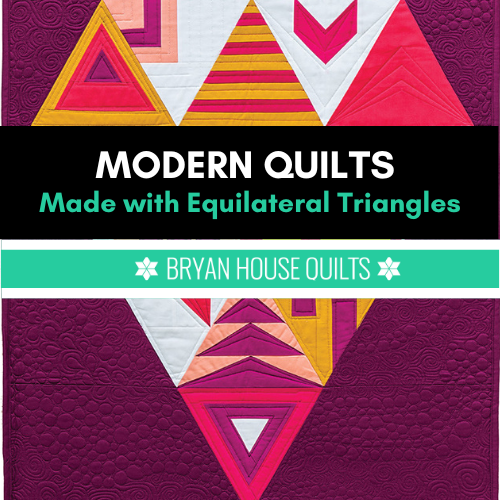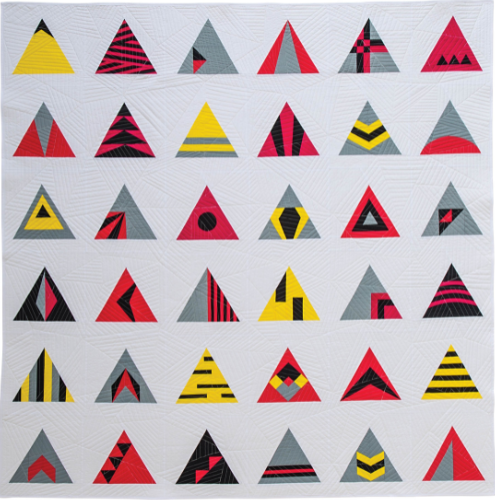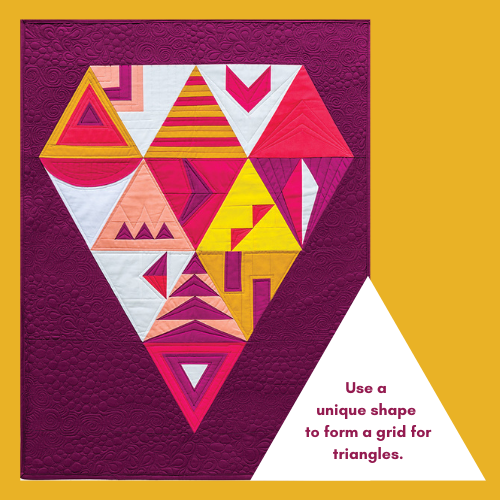
Modern quilts made with equilateral triangles have become more popular with quilters and quilt designers. Methods like foundation piecing with freezer paper make matching points easier. More designers are using triangles in their modern quilts in unique grids and color combinations. Equilateral triangles are dynamic and versatile shapes to explore in your quilting. Read on!
What is an equilateral triangle?
This triangle earned its name by all things being equal! All three sides are equal in length and all angles are 60 degrees. Follow along with me as I show you amazing quilts you can make with these, plus, a tutorial on cutting and prepping fabric, and sewing stretchy seams.
My favorite triangle quilt is made with equilateral triangles as a modern sampler. The bold contrasts with many triangles versions was a fun way to use a modern grid.

When I play, my ideas grow. When I actually sew my ideas, my sewing skills also grow – often without fully knowing what I’ve gotten myself into (I see nodding heads).
Sampler quilts offer an excellent opportunity to showcase a variety of triangle designs in a single project. Combine different colors, fabrics, and arrangements of equilateral triangles, you’ll create a blockbuster.

Make a modern triangle in my free class and learn the magic of Freezer Paper Piecing! Download the free pattern and I’ll walk you step-by-step through the technique. Get started here!
My Quilts Made with Equilateral Triangles
Modern quilters have embraced equilateral triangles, making them into stunning designs. From minimalist layouts to intricate geometric patterns, oh, the possibilities!

One of the most appealing aspects of working with equilateral triangles is how they easily adapt into grids, like the Equilateral Sampler above. Whether you prefer bold and graphic quilts or subtle and sophisticated designs, equilateral triangles offer a versatile foundation for your creativity.
Design with Equilateral Triangle Quilt Blocks
I start a design with a loose idea of the overall design and a bunch of individual blocks in different designs. Then I combine the blocks into interesting segments and rows, sometimes forming larger shapes – hexagon, diamond, parallelogram, rombas – and rotating, pairing and shuffling them around until something cool happens.

Improvisational blocks made with equilateral triangles are fun to play with. There are no rules! See my tutorial where I designed triangles in square blocks for easy piecing.
Hexagon Equilateral Triangle Quilt Designs
Creating hexagons with equilateral triangles is a breeze, and they add a touch of modern sophistication to any quilt top. Sew six equilateral triangles together to make a hexagon. My secret sauce is to sew them into rows first, then attach rows together.

The hexagons are the backbone of the design and hide themselves in plain sight while a large triangle nestles inside the grid…or is it just a triangle?!

Sewing Tips
Always remember to sew with the right sides of the fabric facing each other. Press your seams carefully to create crisp and defined hexagons.
- Starch your fabric before cutting.
- To achieve picture-perfect points, make sure to line up the tips of your triangles precisely. Use a pin to mark the exact point where your seams should intersect, providing a visual guide as you sew.
- Take your time and sew slowly, adjusting your stitch length if necessary to ensure your needle pierces through the point of the triangle.
Rulers and Templates
Having the right tools and methods make a big difference when sewing with equilateral triangles. Specialty quilting rulers and templates simplify the process of cutting and piecing, enabling you to achieve precise results.
I use templates because I love freezer paper piecing, which skips the step of cutting perfect triangles. Then, if needed, I’ll use a trimming template for uniform triangles. Learn all about freezer paper piecing with my Magic Mini Freezer Paper Piecing workshop.
If you’re sewing without foundations, quilting rulers often feature markings tailored explicitly for triangles, making it easy to cut accurate shapes and align your seams perfectly.
One of the most critical aspects of sewing with equilateral triangles is mastering the art of matching points. When points align flawlessly, your quilt achieves a professional and polished look. To achieve perfect points, it’s essential to maintain a consistent seam allowance throughout your project.
With practice and attention to detail, you’ll be matching points like a pro in no time.
Quilting your Equilateral Triangles Quilt
Straight line walking foot quilting is my usual style. I love how the lines can echo the shapes. It’s that simple!
Conclusion
In conclusion, modern quilts made with equilateral triangles offer a fresh and exciting approach to quilting. The versatility of equilateral triangles allows for endless design possibilities, from hexagons to diamonds and sampler patterns. Remember to use rulers and templates for precise cutting and matching points for a polished finish. Whether you’re a beginner or an experienced quilter, incorporating equilateral triangles into your projects can add a modern twist. So, gather your fabrics and sewing tools, and let your creativity soar with these geometric wonders!
Frequently Asked Questions
How Do I Avoid Stretching the Edges of the Triangles?
To prevent stretching, especially on bias edges, starch your fabric before cutting and sewing. Also, handle the fabric gently during piecing, using a consistent seam allowance, and avoid pulling or tugging while sewing.
Are Special Sewing Feet Required for Piecing Triangles?
While not mandatory, a quarter-inch piecing foot can enhance accuracy when sewing triangles. Additionally, a walking foot can be helpful for quilting larger equilateral triangle projects as it feeds the layers evenly. I use a walking foot for all of my sewing.
